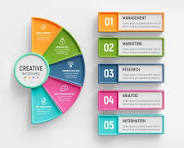Mastering the Art of Infographic Design: A Visual Guide
The Art of Infographic Design
Infographics have become a popular and effective way to visually communicate complex information in a simple and engaging manner. With the rise of digital media, infographic design has evolved into a powerful tool for conveying data, statistics, and ideas across various platforms.
Key Elements of Infographic Design
Effective infographic design incorporates the following key elements:
- Visual Hierarchy: Organising information in a clear hierarchy helps guide the viewer’s eye through the infographic.
- Data Visualization: Using charts, graphs, and diagrams to present data in a visually appealing way enhances understanding.
- Colour Scheme: Choosing an appropriate colour palette can evoke emotions and create visual harmony within the infographic.
- Typography: Selecting readable fonts and text sizes ensures that information is easily digestible for the audience.
- Icons and Illustrations: Incorporating relevant icons and illustrations can add visual interest and aid in storytelling.
The Impact of Infographic Design
Well-designed infographics have the power to capture attention, simplify complex concepts, and increase engagement with content. They are widely used in marketing campaigns, educational materials, reports, presentations, and social media posts to convey information effectively.
Trends in Infographic Design
In recent years, trends in infographic design have shifted towards interactive infographics that allow users to engage with the content dynamically. Animated infographics, scroll-triggered effects, and responsive designs are becoming increasingly popular as they enhance user experience and interactivity.
In Conclusion
Infographic design continues to play a vital role in visual communication by transforming complex data into visually compelling narratives. By combining creativity with data-driven insights, designers can create infographics that inform, educate, and inspire audiences across various platforms.
8 Essential Tips for Creating Effective and Engaging Infographics
- Keep it simple and uncluttered
- Use a cohesive colour scheme
- Choose easy-to-read fonts
- Include relevant and impactful visuals
- Maintain consistency in design elements
- Focus on conveying information clearly
- Utilise white space effectively
- Ensure the infographic is visually engaging
Keep it simple and uncluttered
When it comes to infographic design, a key tip to remember is to keep it simple and uncluttered. By maintaining a clean and minimalist layout, you allow the information to stand out and be easily digestible for the audience. Avoid overcrowding the design with excessive text or graphics, and focus on conveying the message concisely and effectively. Simplicity not only enhances the visual appeal of the infographic but also ensures that the content remains clear and impactful.
Use a cohesive colour scheme
When creating infographics, it is essential to use a cohesive colour scheme to enhance visual appeal and aid in information retention. A harmonious palette not only creates a unified look but also helps in guiding the viewer’s attention to key elements within the infographic. By selecting colours that complement each other and align with the content’s tone, designers can effectively convey information and evoke the desired emotional response from the audience.
Choose easy-to-read fonts
When creating infographics, it is essential to choose easy-to-read fonts to ensure clarity and readability for the audience. Selecting fonts that are clear, legible, and appropriately sized can significantly enhance the overall effectiveness of the infographic design. By opting for simple yet stylish typefaces, designers can convey information seamlessly and make the content more accessible to viewers of all backgrounds. Prioritising readability in font selection is key to ensuring that the message of the infographic is communicated effectively and leaves a lasting impact on the audience.
Include relevant and impactful visuals
When creating infographics, it is essential to include relevant and impactful visuals that complement the data and information being presented. Visual elements such as charts, graphs, icons, and illustrations not only enhance the overall design but also help in conveying complex concepts in a visually engaging way. By choosing visuals that are directly related to the content and resonate with the audience, designers can effectively communicate key messages and make the information more memorable and compelling.
Maintain consistency in design elements
Maintaining consistency in design elements is crucial when creating infographics. By using a cohesive colour scheme, typography, icons, and layout throughout the infographic, designers can ensure visual harmony and improve readability. Consistency helps establish a strong visual identity for the infographic and guides the viewer’s understanding of the information presented. It also reinforces brand recognition and makes the content more aesthetically pleasing and engaging. Keeping design elements consistent across the entire infographic enhances its overall impact and effectiveness in conveying complex data or ideas in a clear and concise manner.
Focus on conveying information clearly
When creating infographics, it is essential to focus on conveying information clearly. By simplifying complex data and using visual elements strategically, designers can ensure that the message is easily understood by the audience. Clarity in infographic design not only enhances comprehension but also increases engagement and retention of the information presented. Prioritising clear communication allows viewers to grasp key points quickly and effectively, making the infographic a powerful tool for sharing knowledge and insights.
Utilise white space effectively
Utilising white space effectively is a crucial tip in infographic design. By strategically incorporating empty spaces around elements, text, and graphics, designers can improve readability and visual clarity. White space helps to create a sense of balance, focus the viewer’s attention on key information, and enhance the overall aesthetic appeal of the infographic. When used thoughtfully, white space can make the design more inviting and easier to navigate, allowing the content to stand out and communicate its message more effectively.
Ensure the infographic is visually engaging
When creating an infographic, it is crucial to ensure that the design is visually engaging to capture the audience’s attention effectively. Incorporating eye-catching colours, appealing graphics, and a clear layout can enhance the overall visual appeal of the infographic. By making use of visual elements that are both aesthetically pleasing and relevant to the content, designers can create an engaging and memorable infographic that effectively communicates the intended message to viewers.


